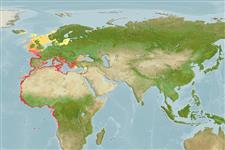>
Carangiformes (Jacks) >
Carangidae (Jacks and pompanos) > Trachinotinae
Etymology: Trachinotus: Greek, trachys, -eia, -ys = rough + Greek,noton = back (Ref. 45335).
More on author: Linnaeus.
Environment: milieu / climate zone / depth range / distribution range
Ökologie
seewasser; brackwasser; tiefenbereich 50 - 200 m (Ref. 27000). Subtropical; 66°N - 13°S, 19°W - 36°E
Eastern Atlantic: Bay of Biscay, British and Scandinavian waters (rare vagrant) to Angola, including the Mediterranean Sea and offshore islands.
Size / Gewicht / Alter
Maturity: Lm ? range ? - ? cm
Max length : 70.0 cm TL Männchen/unbestimmt; (Ref. 57392); common length : 35.0 cm NG Männchen/unbestimmt; (Ref. 26999); max. veröff. Gewicht: 2.8 kg (Ref. 27584)
Rückenflossenstacheln (insgesamt): 7; Rückenflossenweichstrahlen (insgesamt): 23-27; Afterflossenstacheln 3; Afterflossenweichstrahlen: 22 - 25. Diagnosis: body moderately long (its depth 2.6-3.5 times in fork length) (Ref. 57392, 81654) and compressed (Ref. 57392). Upper jaw very narrow at posterior end and extending only to below anterior third of eye; 22-32 gill rakers on lower limb of first gill arch (Ref. 57392). Tongue with small band of teeth (Ref. 81654). 2 dorsal fins, 1st with 6 spines, 2nd with 1 spine and 23-27 soft rays; anal fin with 2 detached spines followed by 1 spine and 22-25 soft rays (Ref. 57392, 81654). Lobes of soft dorsal and anal fins small (Ref. 57392), dorsal fin lobe 3.9-5.6 times in fork length (Ref. 81654). Length of second dorsal fin base equal to length of anal fin base (Ref. 35388). 2nd dorsal-fin lobe and pectoral fins shorter than head; scales small, cycloid, partially embedded in skin; lateral line very slightly arched over pectoral fins, straight thereafter, and without scutes (Ref. 57392). 3-5 black spots along anterior half of lateral line(Ref. 35388, 57392, 81654).
Coloration: back greenish-grey, sides silvery with 3-5 vertically elongate black spots on anterior half of lateral line; dorsal-, anal- and caudal-fin lobes black-tipped (Ref. 57392).
Adults are moderately common in shallow water in areas of surge. Found in clear waters (Ref. 27584), over sand or mud bottoms (Ref. 27000, 57392). Occasionally enters lagoons and river estuaries (Ref. 57392). Form schools (Ref. 27584, 57392). Small specimens are regularly caught at night from steep rocky shores. Adults feed on small crustaceans, mollusks and fishes (Ref. 4233). Eggs are pelagic (Ref. 4233).
Life cycle and mating behavior
Geschlechtsreife | Fortpflanzung | Ablaichen | Eier | Fecundity | Larven
Smith-Vaniz, W.F., 1986. Carangidae. p. 815-844. In P.J.P. Whitehead, M.-L. Bauchot, J.-C. Hureau, J. Nielsen and E. Tortonese (eds.) Fishes of the north-eastern Atlantic and the Mediterranean. UNESCO, Paris. vol. 2. (Ref. 4233)
IUCN Rote Liste Status (Ref. 130435)
Bedrohung für Menschen
Harmless
Nutzung durch Menschen
Fischereien: weniger kommerziell; Aquakultur: kommerziell; Sportfisch: ja
Mehr Information
ReferenzenAquakulturAquakultur ProfilZuchtlinienGenetikElectrophoresesVererbbarkeitKrankheitenVerarbeitungNutrientsMass conversion
Tools
Zusatzinformationen
Download XML
Internet Quellen
Estimates based on models
Preferred temperature (Ref.
123201): 9.8 - 17.3, mean 13.9 °C (based on 181 cells).
Phylogenetic diversity index (Ref.
82804): PD
50 = 0.5000 [Uniqueness, from 0.5 = low to 2.0 = high].
Bayesian length-weight: a=0.01072 (0.00688 - 0.01668), b=2.91 (2.78 - 3.04), in cm total length, based on LWR estimates for this species & (Sub)family-body (Ref.
93245).
Trophic level (Ref.
69278): 3.7 ±0.58 se; based on food items.
Widerstandsfähigkeit (Ref.
120179): mittel, Verdopplung der Population dauert 1,4 - 4,4 Jahre. (Preliminary K or Fecundity.).
Prior r = 0.57, 95% CL = 0.37 - 0.85, Based on 1 stock assessment.
Fishing Vulnerability (Ref.
59153): Moderate to high vulnerability (48 of 100).
Climate Vulnerability (Ref.
125649): Low to moderate vulnerability (33 of 100).
Nutrients (Ref.
124155): Calcium = 70.6 [42.5, 151.8] mg/100g; Iron = 1.64 [0.98, 3.00] mg/100g; Protein = 19.9 [17.9, 22.0] %; Omega3 = 0.444 [0.285, 0.726] g/100g; Selenium = 25.1 [14.2, 43.3] μg/100g; VitaminA = 13.1 [4.3, 35.8] μg/100g; Zinc = 0.739 [0.525, 1.025] mg/100g (wet weight);
